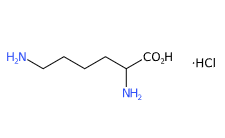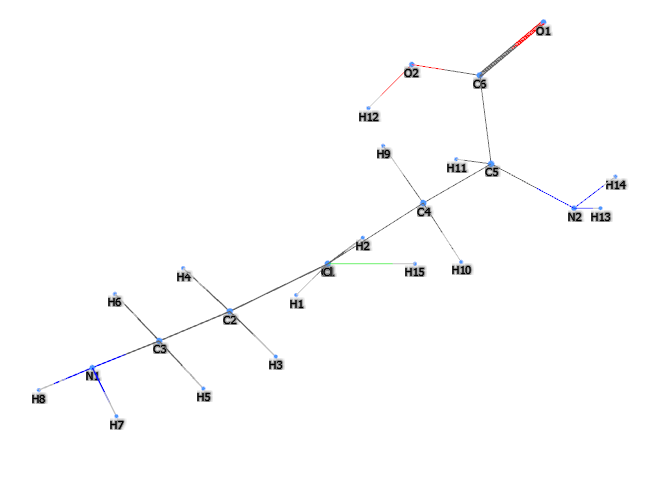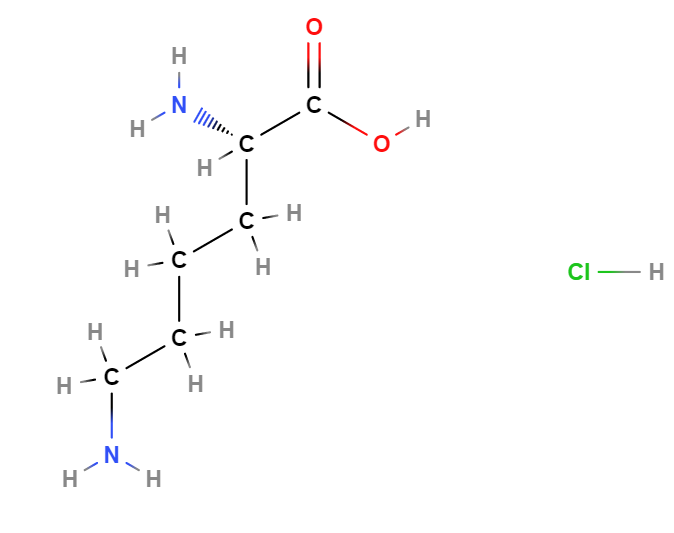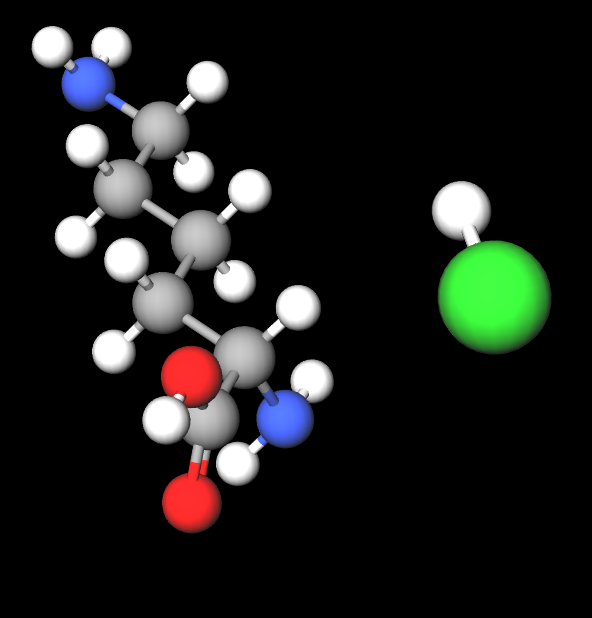| "Descrizione" by CarPas (5242 pt) | 2022-Dec-05 11:35 |
Review Consensus: 10 Rating: 10 Number of users: 1
| Evaluation | N. Experts | Evaluation | N. Experts |
|---|---|---|---|
| 1 | 6 | ||
| 2 | 7 | ||
| 3 | 8 | ||
| 4 | 9 | ||
| 5 | 10 |
Lysine hcl is the hydrochloride salt of Lysine which is part of the 9 essential amino acids for human and animal nutrition. It is not synthesised in the human body and is ingested through diet.
Industrially, the L-isomer has been produced, since the 1950s, by fermentation of gram-positive coryneform bacteria (Corynebacterium glutamicum, Corynebacterium casei, Brevibacterium), which is more advantageous than chemical processes such as acid hydrolysis. L-Lysine is separated and purified (ultrafiltration or centrifugation, separation or ion exchange extraction, crystallisation, drying) and the end result is a powder (1).
It occurs as a white crystalline powder, odourless, easily soluble in water and formic acid, hardly soluble in ethyl alcohol. It melts at 260°C.

What it is used for and where
Amino acids play a key metabolic function in the human body and are constituents of proteins.
As food additives they perform different functions: preservatives, flavour enhancers, food supplements and more.
Amino acids together with their salts are used in cosmetics as conditioning agents for both hair and skin (e.g. as moisturisers and other similar functions). Moisturisers are different in nature: the best are the natural ones that exploit the mechanism of integration between the ingredient and the skin by moisturising the horny hydrolipid film, i.e. the thin protective layer that covers the epidermis protecting it from harmful external microbes, keeping the skin moisturised and supple and its pH or acidity value between 4 and 6. Then there are the occlusive moisturisers, usually derived from petroleum (Paraffinum, Paraffinum liquidum and others), but also triglycerides, lanolin oil, natural or synthetic waxes, fatty acid esters and others that create an artificial occlusive layer on the stratum corneum of the skin with the advantage of accelerating the protective process but with the disadvantage of preventing the skin's natural transpiration.
α-amino acids that have similar physical structures undergo similar changes with regard to solubility in water/ethanol mixtures, and technologies to separate α-amino acids from industrial residues, which may not even be innocuous, are constantly being improved. However, many data on the solubility in water-ethanol and ethanol of some α-amino acids are contradictory or even lacking, and the effects of ethanol on the solubility of amino acids may be different. Overall, the scientific literature considers that α-amino acids do not pose significant problems for human health when taken orally, except in people with certain genetic diseases.
Food safety: amino acid α generally considered safe.
Cosmetic safety: amino acid α generally considered safe when formulated to be non-irritant.
Medical
L-Lysine HCl may play the role of a possible biocompatible adjuvant to enhance the immune response. It may enhance the performance of some drugs and improve their efficiency. The addition of Lysine in the diet may increase the rate of protein utilisation.
L-Lysine has been shown to be safe and effective for prophylaxis of herpes simplex in resurfacing procedures. effective for prophylaxis of herpes simplex in resurfacing procedures, with a similar or lower rate of viral activation than the use of antivirals (2). Lysine supplementation has been useful for the prevention of acne and cold sores.
Cosmetics
Lysine, together with Histidine and Arginine are the three most commonly used amino acids in skin care products as moisturisers.
Animal feeding
Used to improve digestibility of amino acids in diets for growing animals, both lactating and adult, improve the usefulness of feed proteins.
Use: the amount added in feed is 0.1-0.2%.
For more information:
Typical commercial product characteristics L-Lysine HCL
| Appearance | White powder |
| Boiling Point | 311.5ºC at 760 mmHg |
| Melting Point | 263°C |
| Flash Point | 142.2ºC |
| PSA | 89.34000 |
| LogP | 1.72990 |
| Water Solubility | 65 g/100 mL (20 ºC) |
| Specific Rotation | +18.0°~ +21.5° |
| Residue on Ignition | ≤0.20% |
| Loss on Drying | ≤0,50% |
| Dust | ≤0.20% |
| Ammonium Salt | ≤0.01% |
| Heavy Metal - Pb | ≤0.0020 |
| Arsenic | ≤0.0002 |
| Storage | 2-8°C |
 |  |
 |  |
- Molecular Formula C6H15ClN2O2
- Linear Formula H2N(CH2)4CH(NH2)CO2H·HCl
- Molecular Weight 182.65
- Exact Mass 182.648
- CAS 657-27-2
- UNII JNJ23Q2COM
- EC Number 211-519-9
- DSSTox Substance ID DTXSID9029198
- IUPAC (2S)-2,6-diaminohexanoic acid;hydrochloride
- InChI=1S/C6H14N2O2.ClH/c7-4-2-1-3-5(8)6(9)10;/h5H,1-4,7-8H2,(H,9,10);1H/t5-;/m0./s1
- InChl Key BVHLGVCQOALMSV-JEDNCBNOSA-N
- SMILES C(CCN)CC(C(=O)O)N.Cl
- MDL number MFCD00064564
- PubChem Substance ID 24896502
- ChEBI 53633
- RXCUI 6538
- NSC 760110
- RTECS OL5650000
- Beilstein 3563889
- NACRES NA:26
Synonyms
- (2S)-2,6-diaminohexanoic acid;hydrochloride
- L-Lysine, monohydrochloride
- Lyamine
- Darvyl
- L-(+)-Lysine Monohydrochloride
- Enisyl
- (S)-2,6-Diaminohexanoic acid hydrochloride(1:x)
- Lysion
- L-Lysine, hydrochloride (1:1)
- L-Gen
References__________________________________________________________________
(1) Anastassiadis, S. (2007). L-Lysine fermentation. Recent patents on Biotechnology, 1(1), 11-24.
(2) de Castro, V. B., Pires, M. E., de Gusmão, P. R., de Almeida Filippo, A., & da Silva, M. (2019). Lysine hydrochloride use in the prophylaxis of herpes simplex in facial technology-aided procedures. Surgical & Cosmetic Dermatology, 55.
| Evaluate |

